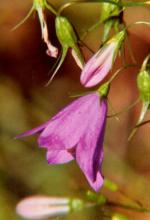Here's a part of the world you don't see very often! I was fortunate to be an on-board naturalist on a cruise ship to Greenland 5 years ago. Here are some images fro the Stromfjord..the longest fjord in the world, I think! The images were taken at 11:00 pm!
Comments
Re: Greenland
Their form of Campanula rotundifolia is far more stout and sturdy, with wider opening and more upright flowers than our upper Midwest form in Minnesota. Leaves are more numerous, wider and with more substance, too.
Are yours like that in New Foundland too, Todd? Trond, do they look like that in Norway also?
In Minnesota:
Re: Greenland
I need to add how breathtaking the scenery is.
Re: Greenland
I will dream about Sisimiut now, Todd ... what a gorgeous place. Wonderful tour of a must-see destination.
Re: Greenland
Greenland (Groenland in Norwegian; Stromfjord actually means "the fjord with (strong) current" (it is Norwegian)) is one of the many places I have on my wish-list!
The harebell/Campanula rotundifolia (blaaklokke = bluebell in Norw.) is very variable her in Norway. We have forms, especially in the mountains and up north, with few but big flowers very similar to this one, and we have plants with smaller and more numerous flowers but longer stalks. The color is variable too from dark to light blue, and occasionally white. Some are tufted and others spread by underground runners. Sorry no good images.
Re: Greenland
Ours are quite variable in Newfoundland but I must admit, I haven't seen any local forms as stout as this one in Greenland...mind you, they are not all stout in Greenland...some more more wiry-stemmed.
Danish must be similar to Norwegian as I have a Greenland wildflower guide in Danish/English and they spell Greenland, Groenland as well.
Re: Greenland
C. rotundifolia is very variable here too. It's a very abundant plant in the Rockies foothills where it turns entire stony plains to blue (a beautiful sight to be seen from the highway while driving to the mountains) - these are much fuller and more robust plants than those pictured from Greenland. The plants at alpine elevations, though, are skinny, little, few- to single-stemmed plants (not especially dwarfed in height, though) - not very showy at all by comparison.
Re: Greenland
Danish must be similar to Norwegian as I have a Greenland wildflower guide in Danish/English and they spell Greenland, Groenland as well.
Written Danish and Norwegian are very similar, not so when spoken. Norwegians usually understand Danes (and Swedes) a little better than vice versa. And regarding Greenland, this island (together with Iceland and the Faeroe Islands (Faeroey meaning sheep-island) once was a part of the kingdom of Norway (from 1261, before that a colony of Norway). When political unions changed in 1814 they were lost to Denmark (meaning "the woods of Danes").
When the Norsemen (actually people from Iceland - with Eiric the Red in front) arrived in the south of Greenland AD1000, this big island was void of people. (The Inuits arrived later from north and west.) People from mainland Norway moved there too. They built 280 farms and 16 churches. The greenlanders depended on regular shipping of goods from Bergen and trade with the mainland. When this commerce petered out the original Norse greenlanders disappeared from history. According to one theory some of them were taken by Portuguese pirates and brought to The Canary Islands as slaves at the sugar plantations (some genetic evidence).
When the new Norwegian and Danish colonization began in 1721 they found only Inuits.
I hadn't thought to write all this history but "the pencil" ran away, your pictures, Todd, got me think of this. Need to go to see for myself!
Re: Greenland
I've come late to this lovely thread.... wonderful photos ,Todd, just super and I have had my pleasure enhanced by Trond's histroy notes.... thanks, Guys!
Maggi
Re: Greenland
Greenland, a great place to visit but i would not want to live there for long. I have had a few chances to go to study falcons there but the timing is always wrong for me. I have a few good friends that go year after year doing research, it seems they get the "Greenland bug" and can't shake it. My friends are a bit perplexed when I tell them that I would really rather look at plants in Greenland than falcons, maybe because i breed these falcons in my back yard. Perhaps someday i will go if the funding ever comes back. Sorry, not a plant picture and off topic.
One of the exquisite creatures of Greenland, the white gyrfalcon and a Peregrine Falcon, getting ready to be flown in the wilds of the Great Basin of north America(excuse my dirty truck).
http://photos.imageevent.com/teita/hawkinsafari/P1010019.JPG
Jim
Re: Greenland
When I saw your avatar I thought you were a falconer! Seems to be an interesting thing to do. In Norway it is strongly forbidden to keep falcons and other birds of prey in captivity.
Re: Greenland
I too enjoy the maritime views and pictures, Todd: you are a dynamo! It is so strange that so many of the same plants, Campanula rotundifolia, Saxifraga cernua, etc. etc. are widespread in our own tundra so far away and so much further south. But then again, today it's snowing in mid May!
I recall flying over Greenland on a recent trip to Europe and gazing down at the vast snowfields and the slender thread of green and wondering what it must be like down there. The flower gardens in the town are a revelation (and must be a real source of pride and delight to the owners!)


The town of Sisimiut